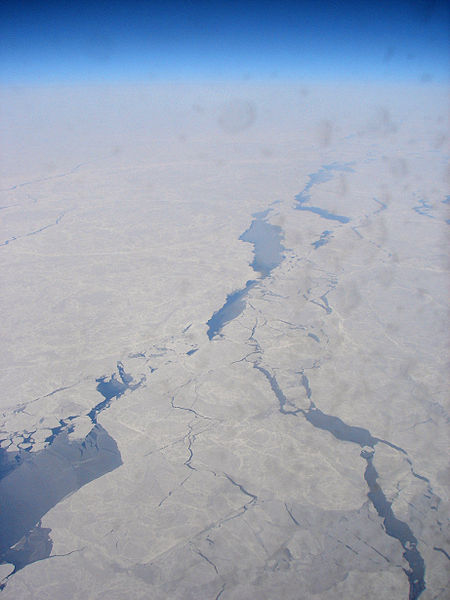Spiegel science journalist Axel Bojanowski has a fascinating piece on what likely causes most of the sea ice to break up. The Spiegel introduction:
Sea ice is disappearing in the Arctic, around the Antarctic it is growing – today’s conventional climate models are unable to explain this contradiction. One effect has just been measured by sensors: wave motion is able to crack ice, hundreds of kilometers away.”
 The Spiegel report explains how oceanic mechanical waves induced by large storms offshore propagate underneath sea ice and act to break it apart even hundreds of miles far into the ice sheet. Bojanowski cites a north Pacific storm near Alaska which created huge waves in 2005. “Six days later the surges ripped apart the B15A iceberg 13,500 km to the south.”
The Spiegel report explains how oceanic mechanical waves induced by large storms offshore propagate underneath sea ice and act to break it apart even hundreds of miles far into the ice sheet. Bojanowski cites a north Pacific storm near Alaska which created huge waves in 2005. “Six days later the surges ripped apart the B15A iceberg 13,500 km to the south.”
Photo: Creative Commons Attribution-Share Alike 3.0 Unported license
The new hypothesis is based on a recent study by Alison Kohout of the New Zealand National Institute of Water and Atmospheric Research in Nature.
Scientists placed sensors on a section of the Antarctic ice sheet to measure ocean wave induced oscillations. When storms hit offshore, the ice sheet began to resonate and cracks developed due to the cyclic loading. Spiegel writes that cracks even hundreds of kilometers into the ice sheet resulted.
The scientists examined weather data between 1997 and 2009. They clearly observed that sea ice broke up as result of storms hundreds of kilometers away. Sea ice over water that bordered regions of relatively calm waters that saw low storm activity remained relatively intact.
Many global warming scientists insist ice break-up is likely caused mostly by warming. But the results of the study refute the claim and show that climate models have gotten it all wrong again. Bojanoawski writes on storm-induced ocean waves and ice break-up:
In the calculations such destruction is hardly taken into account by the models, which simulate sea ice. Up to now they have failed to depict the observed changes: …”
But the Alfred Wegener Institute is skeptical of the study’s result, claiming that it neglected to take wind into account.
It’s a good point, but here we see that even the warmist Alfred Wegener Institute indirectly admits that sea ice break-up is in large part driven by mechanical ocean wave dynamics and wind forces.
Bojanowski writes that the destructive effects of ocean waves are documented in the Arctic as well, citing how in 2012 “a huge storm ripped apart an area of sea ice three times the size of Germany in just 10 days“. He adds that the wave effect exascerbated the break-up as deeper warm water was agitated and brought up to the surface and melted the sea ice like “an ice cube in a tea cup.”
Whatever the warmists may argue, one thing is sure: Sea ice break-up is far more complex and there is a growing body of evidence showing that it is due in large part to mechanical ocean dynamics and wind conditions.
See excellent photos.





When you only believe in hammers (warming), everything looks like a nail (melting).
Confirms once again how unrealistically simple warmists view the world and how little understanding they really have of climate science.
[…] Link to NoTricksZone article Follow his link to the Spiegel photos, magnificent. […]
There is also Infragravity waves:
Infragravity waves generated along the Pacific coast of North America have been observed to propagate transoceanically to Antarctica and there to impinge on the Ross Ice Shelf. Their frequencies more closely couple with the ice shelf natural frequencies and they produce a larger amplitude ice shelf movement than the normal ocean swell of gravity waves. Further, they are not damped by sea ice as normal ocean swell is. As a result they flex floating ice shelves such as the Ross Ice Shelf; this flexure contributes significantly to the breakup on the ice shelf.
http://en.wikipedia.org/wiki/Infragravity_wave
It is claimed by some that the disappearance of the Arctic ice will accelerate regional warming due to the decrease in the surface albedo. That is, the white of ice and snow deflects the heat. If this is the case, then more extreme weather, be it storms or wind, could be the cause of warming, not the consequence.